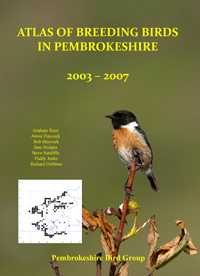Streptopelia decaocto
Collared Doves nested in Ireland in 1959, two years before the first breeding record for Pembrokeshire, indicating that some outstripped the general westward expansion. A possible link with movement to Ireland was supplied by birds temporarily stopping off at Skokholm from 1962, Skomer from 1963 and at Grassholm in 1969. There were just a few records of birds actually seen flying out to sea, the most notable being 26 doing so at the South Bishop on the 17th May 1976. This contrasts with “heavier traffic” noted departing Anglesey (Jones and Whalley, 2004), even though Pembrokeshire is a little closer to Ireland.
It was recorded as breeding in every 10 Km square in Pembrokeshire by the first breeding birds atlas for Britain and Ireland, covering 1968 – 72, the second, or New Atlas, of 1988 – 91 depicted a similar distribution but a relative abundance lower than for southern England. The Pembrokeshire atlas of breeding birds, 1984 – 88, plotted distribution on a tetrad grid, that is groups of four 1 Km squares, occupancy being registered in 56 % of them and breeding being confirmed in 73 tetrads. The repeat Pembrokeshire survey of 2003 – 07 indicated occupancy in 65 % and confirmed breeding in 76 tetrads.
Breeding distribution 1984-88
Breeding distribution 2003-07
|
Breeding surveys
|
1984 – 88
|
2003 – 07
|
|
Total tetrads where found
|
265
|
305
|
|
Confirmed breeding
|
73
|
76
|
|
Probable breeding
|
113
|
197
|
|
Possible breeding
|
79
|
41
|
Comparison of the two survey results shows a 15 % increase in distribution by the latter period. This compares with an 18 % increase in Wales as a whole between 1984 and 2007 noted by the BBS. The estimated Pembrokeshire breeding population of 1,600 – 2,100 which accompanied the survey of 1984 – 88 was based on a range of six to eight pairs per occupied tetrad, an attempt to cater for higher densities in suburban areas than in isolated homesteads. The same situation prevailed during the 2003 – 07 survey, so applying the 15 % increase to the earlier estimate suggests a breeding population in the range of 1,830 to 2,440 pairs in the county.
Despite a wide distribution in the county the Collared Dove is not evenly spread. It has been found to have a close association with human habitation, occurring around farms, small holdings and gardens but it is generally absent from more open countryside. Although it will eat invertebrates and green plant matter it mainly feeds on seeds. Locally these have included grain, both spilled and strewn for poultry, a variety of seeds put out on bird tables, the seeds of garden plants and grasses and bread put out for birds generally.
Graham Rees
(Covers records up to and including 2008).
 Friday, November 11, 2011 at 11:50AM
Friday, November 11, 2011 at 11:50AM 










